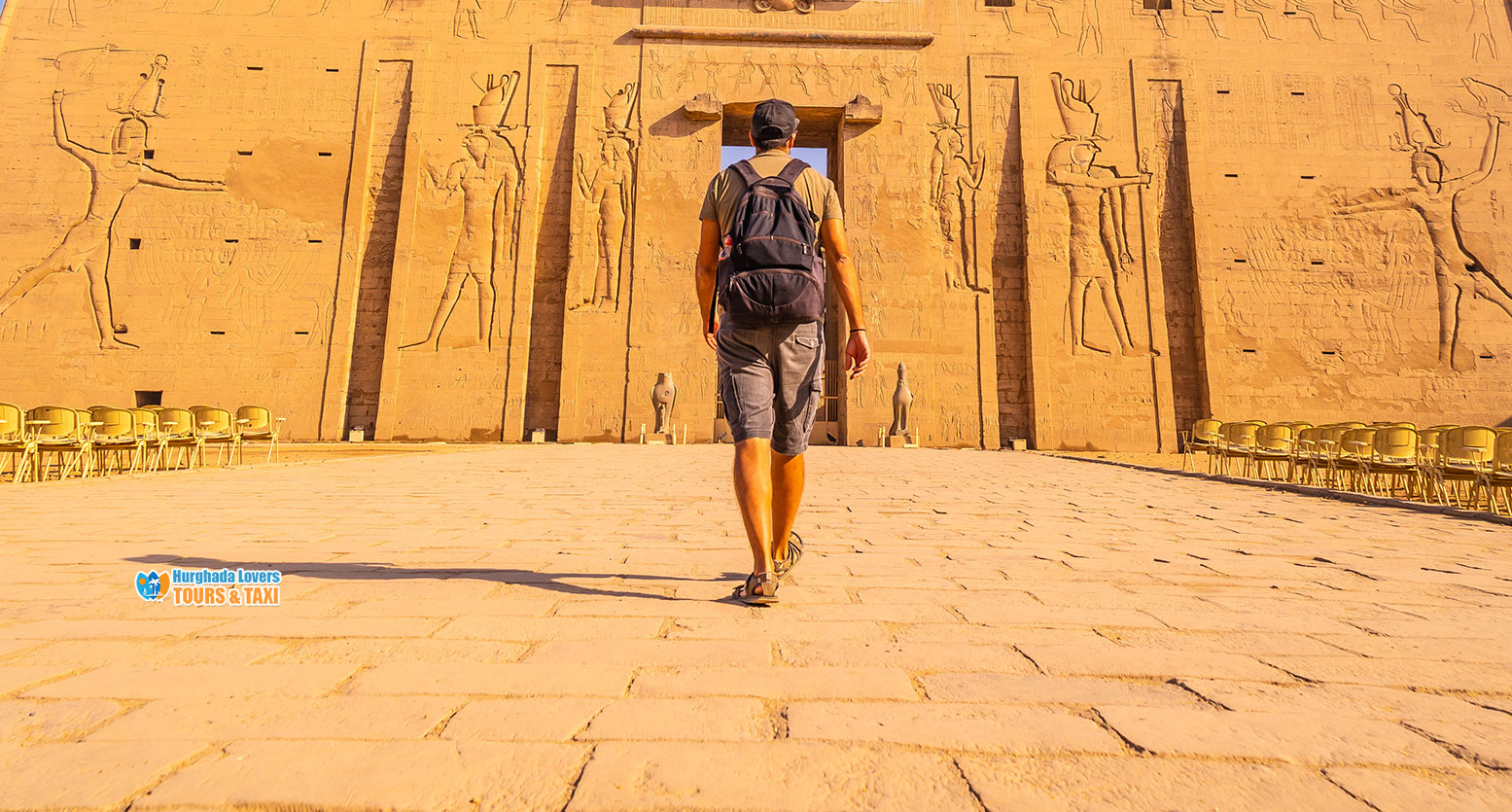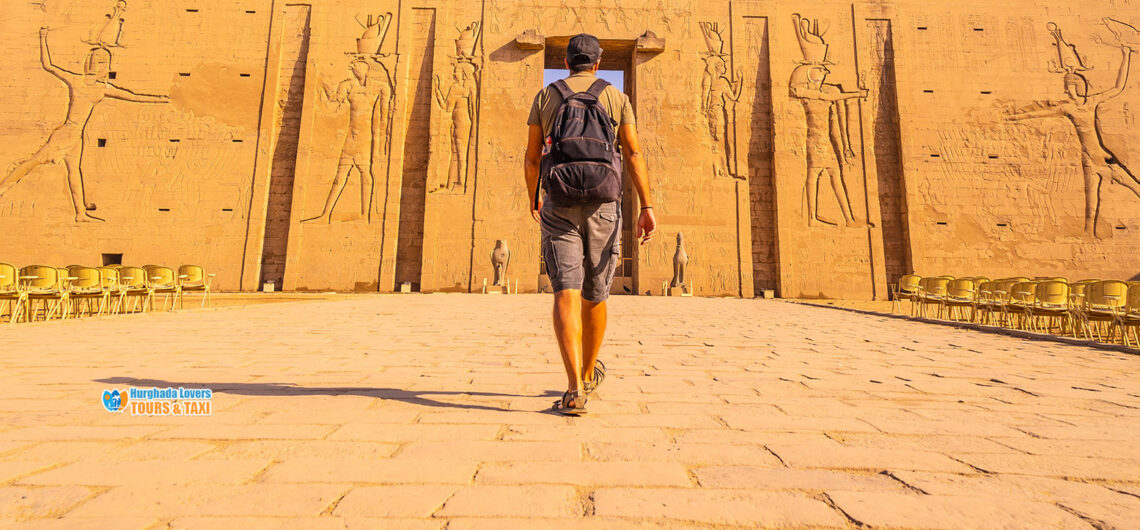Pharaonic Village in Cairo, Egypt | The facts of creating the most beautiful tourist attractions in Cairo to see how the life of the ancient Egyptians was the pharaohs using actors dressed in costumes of the ancient Egyptian and how much is the entrance ticket, what is inside and more.
The Pharaonic Village is a village that includes features of the ancient pharaonic life using representatives dressed in ancient Egyptian costumes.
Hurghada lovers Offer Luxury Hurghada to Pyramids Tours | El Gouna to Pyramids Tours | Makadi bay to Pyramids Tours | Sahl Hasheesh to Pyramids Tours | Soma bay to Pyramids Tours .
Pharaonic Village
• The idea of the pharaonic village goes back to Dr. Hassan Rajab, and the goal and vision of Dr. Hassan was to create a living museum that includes the features of pharaonic life.
• In 1974, the doctor began transforming an island called “Yacoub” into a model very close to the life of the ancient Egyptians.
• The doctor relied on a set of steps while working in that village, and the first step was the implant.
• Where the doctor planted nearly 5,000 trees in order to be a natural barrier to the appearances of modern Cairo outside, instead of using the modern fence.
• Certain types of trees were selected, including sycamore, palm and willow trees.
• The next step was the construction of the noble’s house in addition to its outbuildings such as the garden, the market and the cultivation of a large field as well.
• The village contains a boat workshop, as well as roads made of huge white stone.
• The village was opened in 1984 and the cost of the village was approximately six million dollars.
• Dr. Abd al-Salam joined the village administration in 1989, when it was in a stage of development.
Inside the pharaonic village
• Upon entering the village, you will find a buoy that contains a small cafeteria.
• On the upper floor of the buoy there is the Cleopatra Museum.
• In the Pharaonic village there is a tour guide who explains to you information about Cleopatra and Julius Caesar, and the events that occurred in that era.
• The trip begins after completing the view of the Cleopatra Museum by riding the floating boat.
• The boat transports visitors to water channels surrounding the pharaonic village, and there is a guide explaining to you the ancient Egyptian deities, as well as a scene about the Prophet Moses.
• The guide also explains general information about the papyrus plant and the method of its manufacture, in addition to explaining the methods of mummification and how ancient pottery and glass were made.
• Other information that you can learn after visiting the village is information about farming, irrigation and hunting methods in ancient Egypt.
• A brief description of the hieroglyphs is also explained, and the information is presented through representative scenes.
Pharaonic Village Museums
• The museums in the pharaonic village are not the museums of ancient pharaonic Egypt, but there are museums of modern Egypt.
• There is a museum of the Ptolemaic era in addition to a museum of Pharaonic Egypt’s heritage, as well as the Museum of Beliefs and the Museum of Boats.
• The Islamic Museum is one of the museums located in the Pharaonic Village, next to the Museum of President Mohamed Naguib, the first president of the Arab Republic of Egypt.
• There is a museum for Gamal Abdel Nasser and Anwar Sadat, in addition to the Coptic Museum and the Pyramids Museum.
Mummification Museum and the Museum of Modern Egypt are among the famous museums inside the village. There are also models of Egyptian clothing throughout the ages and famous battles.
President Gamal Abdel Nasser Museum
• Gamal Abdel Nasser Museum It was designed to illustrate the life of the late Egyptian President Gamal Abdel Nasser from birth to death.
• The museum is located on the banks of the Nile, and the museum contains more than 150 rare pictures of President Gamal Abdel Nasser in the stages of his life.
• The museum also has old coins and stamps, along with letters to the president dating back to 1941 AD.
• The text of the decision to nationalize the Suez Canal for the year 1956 AD from the letters inside the museum.
• Next to President Gamal Abdel Nasser Museum, there is also a museum for President Mohamed Anwar Sadat.
• The last museum contains the president’s personal belongings, and the navy suit in which the president attended the opening of the Suez Canal.
• Among the collections in the museum are the president’s perfume and his toothbrush, as well as the late president’s famous wand.
• There are pictures of his wives and children, as well as pictures of the president during his life and during his ablution as well.
• Inside the museum there is a model showing how the Bar Lev Line was confronted by the Egyptian armies.
Tutankhamun’s tomb
• The tomb of Tutankhamun is one of the tombs found in the Pharaonic village.
• The tomb comes in the same size as the original tomb as well as the design, and there is a group of artifacts that were with the tomb.
• The tomb in the village is divided into 4 rooms, and the first room contains three gold-plated beds, in addition to the king’s food and other belongings.
• The second room in the tomb contains pottery utensils, the king’s weapons, and a game of chess that was used by the king.
• There are four compartments in the third room, which is the burial room, in which the bodies were discovered, and there is a pure gold coffin.
Pharaonic Village
The most important tourist attractions in Cairo and Giza, Egypt, to tell us the history of the ancient civilization of Egypt, what are the working hours, entry ticket prices, what it includes from the inside, and more.
The most important cultural tourist places for the Egyptian Pharaonic antiquities in Egypt Tourism, learn about working hours, ticket prices and everything you need to know to make an enjoyable entertainment trip to one of the most important tourist places that can be visited in the Great Sea Saqiyat Makki, Giza Governorate, south of Cairo
During your visit you will get an unparalleled experience. Where you are in the shadow of the ancient Pharaonic civilization, and you feel as if you have traveled through time to a distant past.
About the Pharaonic Village
There is a miniature model of the life of the ancient pharaohs in the Al-Munib neighborhood in Giza Governorate, from the life of sculptors to the life of peasants to the life of craftsmen and other features of ancient pharaonic life.
The Pharaonic Village is characterized by being a living open museum, which displays the various activities of ancient Egyptian life in one place, and with Egyptian actors, who wear makeup similar to what the ancient Egyptians used to do, which puts you on a journey through history to the distant past.
Places to visit inside the Pharaonic Village
There are many visits, scenes, and activities that you can do in the Pharaonic Village, such as the Cleopatra Museum, and the Nefertari Yacht, through which you can take an enjoyable Nile cruise, in which you can see the various features of the amazing Pharaonic Village.
Also in the Pharaonic village, you can see papyrus plants that the ancient Egyptians used to write, a model of Tutankhamun’s tomb, and another of the pyramids, in addition to a number of contemporary and ancient art galleries.
It also includes the Museum of Coptic Art, the Museum of Mummification, the Napoleon Gallery, the Sadat Museum, the Museum of Inventors, and the Museum of Modern History in Egypt.
And a model of the Peasants’ House and another that displays scenes from ancient agriculture, and the Nubia History Museum, which tells the history and life of the Nubians, the Boat Museum, and the China Museum.
The Pharaonic Village has many restaurants, cafes, and other places of entertainment and picnics, which makes it the first choice for outings for young men, girls, and families alike.
What awaits you inside the Pharaonic village?
The Pharaonic Village is not a set of static exhibits, but rather a place full of vitality, through its urban parks for children in Egypt.
And from the boats that she uses on a Nile cruise inside the village, headed by a Nefertari yacht, where one round takes about an hour, and some snacks are available.
You can also shop in the Pharaonic Village, where there are many souvenir shops, many of which are handcrafted in the village by the same expert craftsmen.
Address: The village is located on the west bank of the Nile, on Jacob’s Island at 3 Bahr al-Azam Street, about six miles from the center of Cairo.
work hours:
The village is open from 9 am to 5 pm daily
In the summer months, it is open until 7 pm
Entry Fee: Trip fees vary depending on the program you choose
Address: 3 El Bahr El Aazam, Saqiet Mekky, Giza, Egypt,
Dates to visit the Pharaonic Village
Daily from 9:00 in the morning until 5:00 in the evening.
The price of the entrance ticket to the Pharaonic Village
The price of the ticket varies according to the program of the visit, the ticket price starts from 100 EGP up to 200 EGP.


